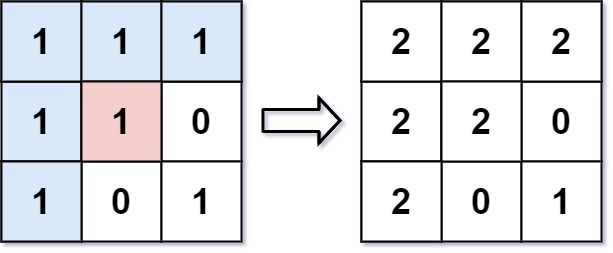733. 图像渲染
点击上方,跳转至leetcode
题目描述
有一幅以 m x n 的二维整数数组表示的图画 image ,其中 image[i][j] 表示该图画的像素值大小。
你也被给予三个整数 sr , sc 和 newColor 。你应该从像素 image[sr][sc] 开始对图像进行 上色填充 。
为了完成 上色工作 ,从初始像素开始,记录初始坐标的 上下左右四个方向上 像素值与初始坐标相同的相连像素点,接着再记录这四个方向上符合条件的像素点与他们对应 四个方向上 像素值与初始坐标相同的相连像素点,……,重复该过程。将所有有记录的像素点的颜色值改为 newColor 。
最后返回 经过上色渲染后的图像 。
示例 1:

输入: image = [[1,1,1],[1,1,0],[1,0,1]],sr = 1, sc = 1, newColor = 2 输出: [[2,2,2],[2,2,0],[2,0,1]] 解析: 在图像的正中间,(坐标(sr,sc)=(1,1)),在路径上所有符合条件的像素点的颜色都被更改成2。 注意,右下角的像素没有更改为2,因为它不是在上下左右四个方向上与初始点相连的像素点。
示例 2:
输入: image = [[0,0,0],[0,0,0]], sr = 0, sc = 0, newColor = 2 输出: [[2,2,2],[2,2,2]]
提示:
m == image.lengthn == image[i].length1 <= m, n <= 500 <= image[i][j], newColor < 2160 <= sr < m0 <= sc < n
解法
方法一:深度优先DFS
深度优先,使用递归,记录更改像素原始颜色,递归修改初始更改像素的上下左右元素颜色,若与原始颜色相同,即同步更改,若不同则不更改。其中更改像素颜色与第一个要更改的原始像素颜色一致的话,即全部像素不用修改。
方法二:广度优先DFS
BFS 广度优先,使用队列
开始给初始位置元素更新颜色,并入队,循环队首出队,对队首元素的上下左右元素进行判断,
若颜色与最初颜色一致,则更新颜色并入队,不一致,不入队,也不修改颜色,直到所有入队元素都出队结束
复杂度分析
时间复杂度:\(O(n\times m)\),其中 \(n\) 和 \(m\) 分别是二维数组的行数和列数。最坏情况下需要遍历所有的方格一次。
空间复杂度:\(O(n\times m)\),其中 \(n\) 和 \(m\) 分别是二维数组的行数和列数。主要为队列的开销
Python3
DFS:
class Solution:
def floodFill(self, image: List[List[int]], sr: int, sc: int, color: int) -> List[List[int]]:
n, m = len(image), len(image[0])
currColor = image[sr][sc]
def dfs(x: int, y: int):
if image[x][y] == currColor:
image[x][y] = color
for mx, my in [(x - 1, y), (x + 1, y), (x, y - 1), (x, y + 1)]:
if 0 <= mx < n and 0 <= my < m and image[mx][my] == currColor:
dfs(mx, my)
if currColor != color:
dfs(sr, sc)
return image
BFS:
class Solution:
def floodFill(self, image: List[List[int]], sr: int, sc: int, color: int) -> List[List[int]]:
currColor = image[sr][sc]
if currColor == color:
return image
n, m = len(image), len(image[0])
que = collections.deque([(sr, sc)])
image[sr][sc] = color
while que:
x, y = que.popleft()
for mx, my in [(x - 1, y), (x + 1, y), (x, y - 1), (x, y + 1)]:
if 0 <= mx < n and 0 <= my < m and image[mx][my] == currColor:
que.append((mx, my))
image[mx][my] = color
return image
C++
DFS:
class Solution {
public:
const int dx[4] = {1, 0, 0, -1};
const int dy[4] = {0, 1, -1, 0};
void dfs(vector<vector<int>>& image, int x, int y, int currColor, int color) {
if (image[x][y] == currColor) {
image[x][y] = color;
for (int i = 0; i < 4; i++) {
int mx = x + dx[i], my = y + dy[i];
if (mx >= 0 && mx < image.size() && my >= 0 && my < image[0].size()) {
dfs(image, mx, my, currColor, color);
}
}
}
}
vector<vector<int>> floodFill(vector<vector<int>>& image, int sr, int sc, int color) {
int currColor = image[sr][sc];
if (currColor != color) {
dfs(image, sr, sc, currColor, color);
}
return image;
}
};
BFS:
class Solution {
public:
const int dx[4] = {1, 0, 0, -1};
const int dy[4] = {0, 1, -1, 0};
vector<vector<int>> floodFill(vector<vector<int>>& image, int sr, int sc, int color) {
int currColor = image[sr][sc];
if (currColor == color) {
return image;
}
int n = image.size(), m = image[0].size();
queue<pair<int, int>> que;
que.emplace(sr, sc);
image[sr][sc] = color;
while (!que.empty()) {
int x = que.front().first, y = que.front().second;
que.pop();
for (int i = 0; i < 4; i++) {
int mx = x + dx[i], my = y + dy[i];
if (mx >= 0 && mx < n && my >= 0 && my < m && image[mx][my] == currColor) {
que.emplace(mx, my);
image[mx][my] = color;
}
}
}
return image;
}
};